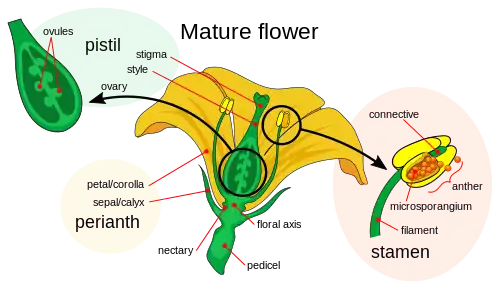Perianth
The perianth (perigonium, perigon or perigone in monocots) is the non-reproductive part of the flower. It forms an envelope surrounding the sexual organs. [1]

A mature flower. In this example the perianth is separated into a calyx (sepals) and corolla (petals)
It includes the calyx (sepals) and the corolla (petals) when called a perigone.
The term perianth is got from the Greek περί (peri, "around") and άνθος (anthos, "flower"). Perigonium is got from περί (peri) and γόνος (gonos, "seed, sex organs").
In the mosses and liverworts (Marchantiophyta), the perianth is the sterile tubelike tissue that surrounds the female reproductive structure (or developing sporophyte).
References
- Beentje H. & Williamson J. 2010. The Kew Plant Glossary: an illustrated dictionary of plant terms. Royal Botanic Gardens, Kew: Kew Publishing.
This article is issued from Wikipedia. The text is licensed under Creative Commons - Attribution - Sharealike. Additional terms may apply for the media files.